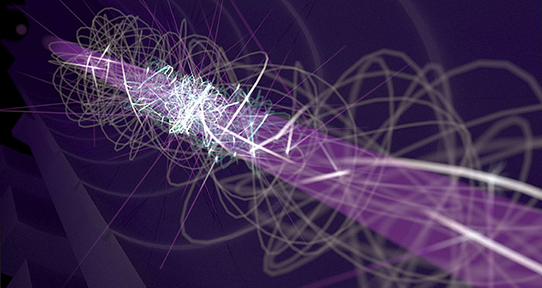Made-in-Canada laser first in world to trap antimatter
Alf Wilson, Faculty of Science

An artistic illustration of the movement of an antihydrogen atom in the ALPHA magnetic trap, before and after laser cooling (grey before, blue after). The images show various lengths of the antihydrogen's track. CREDIT: Chukman So/TRIUMF
University of Victoria physicist Art Olin is part of the first team to trap antimatter atoms using lasers. Read more about their Nature cover-story in this UVic News story.
Antimatter isn’t the opposite of matter, rather the properties of antimatter mirror those of matter. Special Relativity and Quantum Mechanics showed us a century ago that it must exist. So, it’s as fundamental to understanding our universe as normal matter. Yet it is so difficult to create, contain, and observe that we still don’t know if it falls up or down.
Multiple international research teams at CERN are competing to answer this and other fundamental questions about antimatter. UVic’s Adjunct Prof. Art Olin and TRIUMF are playing a key role within one of these international teams: The ALPHA collaboration, which includes over 50 researchers from 22 institutions including Canada, the UK, the US, Denmark, and Sweden. As explained in their recent Nature cover-story, the ALPHA collaboration’s Canadians are racing to cool anti-hydrogen atoms using lasers specially developed at UBC and be the first to answer fundamental questions about antimatter.
Why can’t we just put antimatter in a container and study it?
Difficult to make, antimatter is even more difficult to contain. When matter and antimatter come into contact, matching (mirror) particles mutually annihilate releasing energy (E=mc2). Although ALPHA’s antihydrogen is cold by human scales (-253°C) it is still so energetic that much of it is quickly lost to collisions with apparatus walls. So, lasers and complex magnetic fields are used to cool and confine the antihydrogen. But these magnetic fields need to be so strong that they interfere with observing how antihydrogen interacts with gravity. This is why laser-cooling is so important; a weaker magnetic field can be used, allowing the researchers to see antimatter interact with the gravitational field from our normal matter.
How does Laser cooling (trapping) work?
Although laser-cooling (or trapping) of atoms was first demonstrated 40 years ago, ALPHA is the first to use this technique on antimatter.
It may seem odd to slow atoms by adding laser energy, but it’s like slowing a child on a rope-swing by pushing. If we push with the ‘wrong’ timing (when the child approaches) they will lose energy and slow down. In ALPHA, antihydrogen is the child, the magnetic field is the rope, and the laser is the pushing adult. If the laser is tuned to precisely the ‘wrong’ (Doppler-shifted) frequency, the laser light will slow the antihydrogen atoms. Their goal: one-thirtieth of a degree above absolute zero. When antihydrogen is this cold, the antimatter atoms slow to a stroll (<4 km/H), and the magnetic field can be weak enough to see gravity act on anti-atoms.
What is Art Olin’s main focus?
Art Olin's work within the ALPHA collaboration is helping to determine the spectroscopy (the colour) of antihydrogen to increasingly extreme precision. In hydrogen a single electron orbits a single proton, but in antihydrogen, a positron (positively-charged antielectron) orbits an antiproton. Hydrogen will absorb or emit a specific amount of energy when its electron jumps between the 1S (ground) and 2S (excited) states. For antihydrogen, we do not know if the 1S-2S energy is the same as hydrogen. The ALPHA collaboration has resolved antihydrogen 1S-2S energy to a precision of 2 parts in 1012 (equivalent to one minute in a million years). Their goal is to increase this precision by 2000 times and match the current precision of the hydrogen 1S-2S measurement (1 part in 1015). Staggering to visualize, this is equivalent to two-and-a-half minutes out of the entire age of the Earth (4.5 billion years).
When will we know more?
The ALPHA collaboration hopes to know if antimatter shines with the same colour (has the same spectrum) as normal matter within the next year. Soon after, or perhaps in parallel, they should be able to report if antimatter falls at the same rate as normal matter, and in which direction.
